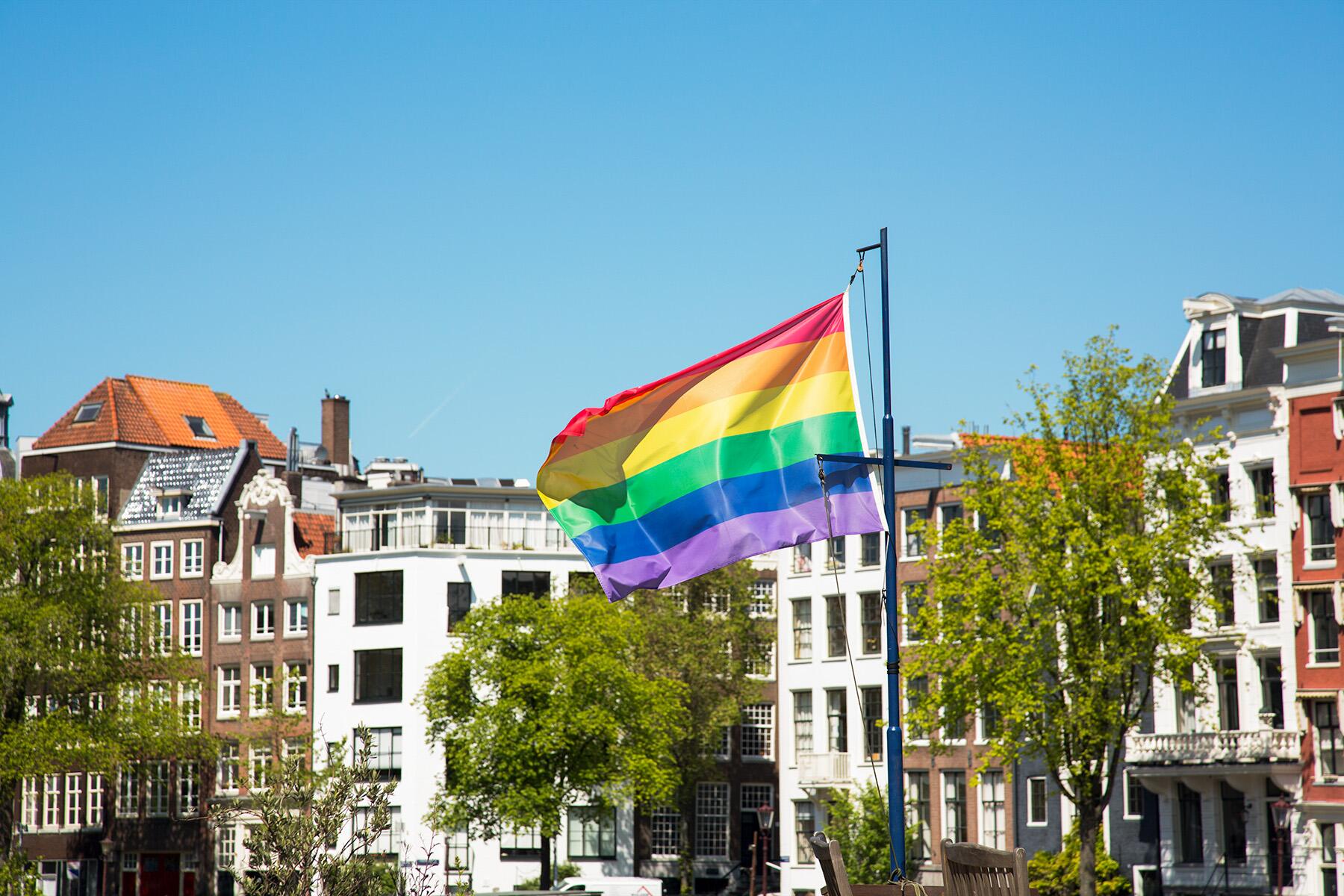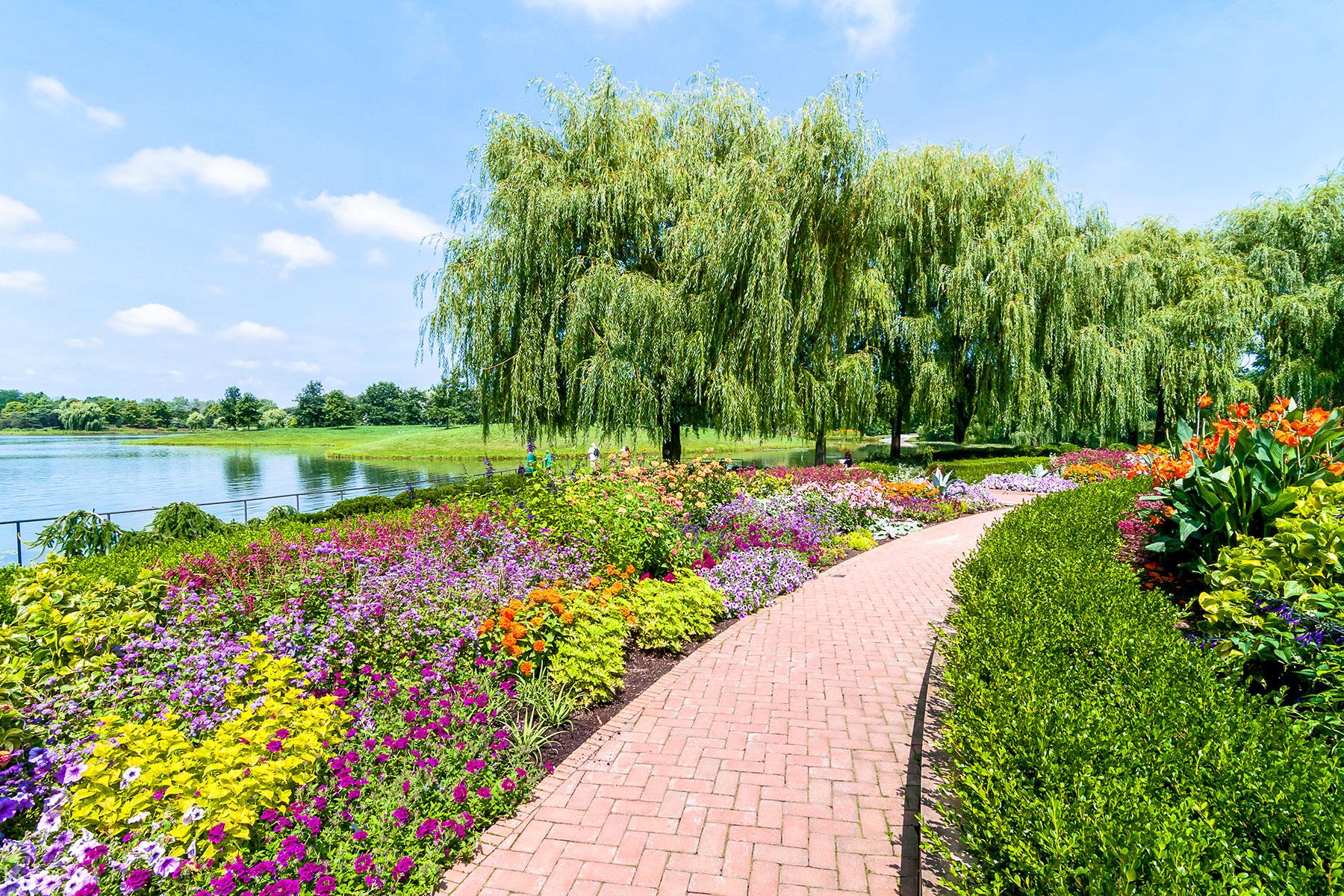Spend a few hours or a whole day exploring America's most beautiful gardens that welcome visitors free of charge.
With wisteria-draped pergolas to flower-lined pools, a visit to a botanical garden is romantic and relaxing. In any season, botanical gardens can feel like a vacation from your vacation. Better still—admission to these beautiful U.S. gardens won’t cost you a dime.
Chicago Botanic Garden
WHERE: Glencoe, Illinois
At nearly 400 acres, the Chicago Botanic Garden is so big, visitors need an app to get the most out of their trip. You can’t see everything in one day, so pick your favorite themed gardens—there are 27—and enjoy the variety. The compact English Walled Garden, with brick walls and stone urns, clematis, and cowslips, is a studied recreation of another time and place. In contrast, Evening Island is naturalistic: broad meadows, lake views, and the carillon bells tolling on summer nights.
Highland Park
WHERE: Rochester, New York
This upstate New York green space designed by famed landscape artist Frederick Law Olmsted is always pleasant for a picnic or afternoon amble, but it’s spectacular in May when thousands of lilacs turn Highland Park purple. The annual Lilac Festival marks the occasion with food, music, and fanfare for two weekends when they’re at their peak. Beyond the lilacs, browse rhododendrons, magnolias, irises, and dogwoods spread across 150 acres. Look for the bed of 10,000 multi-colored pansies, planted in a different design each year.
INSIDER TIPDon’t miss Warner Castle, an 1850s mansion styled after a Scottish castle, with a sunken garden in the backyard.
Recommended Fodor’s Video
Alcazar Garden
WHERE: San Diego, California
You’ll have plenty of gardens to choose from when you visit the 1,200-acre Balboa Park, home to native plant displays, a conservatory, canyon, and more. By comparison, the Alcazar Garden is small, but it makes up in color what it lacks in size. Sandwiched between two museums and bordered with boxwood hedges, the space was designed to match the formal lawn of the Alcazar Castle in Seville, Spain. Red and yellow annuals are somewhat outshone by the twin stars of the courtyard: geometric fountains patterned with turquoise, green, and amber Moorish tiles.
INSIDER TIPThe quintessential photo of Balboa Park, with flowers and king palm trees in the foreground and the ornate California Tower in the distance, is taken from the Alcazar Garden.
United States Botanic Garden
WHERE: Washington, D.C.
Competing with Smithsonian museums and historic monuments, the United States Botanic Garden is sometimes overlooked on the National Mall, but it shouldn’t be. Besides impressive collections of plants, many rare or endangered, the garden features rotating exhibits that highlight botanical art. As a bonus, it’s also three gardens in one: the conservatory, the National Garden outdoors, and the smaller Bartholdi Park across the street. The National Garden spotlights native plants while Bartholdi Park is famous for its dramatic 30-foot Fountain of Light and Water. Spend most of your time indoors—the ecosystems in the conservatory range from desert to rainforest in maze-like rooms crowded with a dizzying pageant of flora.
International Rose Test Garden
WHERE: Portland, Oregon
It’s only fitting that you’ll find the International Rose Test Garden in the City of Roses. Set inside Portland’s vast urban playground, Washington Park, the garden is a serious affair for botanists. There are more than 650 rose varieties, and experts conduct real trials there to see what produces the finest blooms. But you don’t need to care about horticulture to enjoy the 7,000 roses in shades that challenge the imagination: lavender, gold, peachy red, cream tinged with pink. Lined in carefully cultivated rows, the rose bushes are at their best in the summer.
INSIDER TIPFrom April to October, hop a free ride on the Washington Park shuttle. It stops at the rose garden as well as other park sites, like the zoo and arboretum.
Miami Beach Botanical Garden
WHERE: Miami Beach, Florida
An island oasis of orchids and palms, Miami Beach Botanical Garden grows dozens of flowering shrubs and trees like you’d see in a South American forest, some with leaves the size of your head. Water is a prominent feature here, bubbling up from fountains, ponds, waterfalls, wetlands, and the nearby canal. The garden grows plenty of edibles, too, like pomegranates and papayas, and even coffee plants.
INSIDER TIPThe most fragrant spot in the garden is under the ylang-ylang tree, which gives off a heady aroma, familiar to some as a key scent in Chanel No. 5.
Brookside Gardens
WHERE: Wheaton, Maryland
It’s almost surprising to discover the peaceful Brookside Gardens just 30 minutes north of Washington, D.C. A mile-long path circles past diverse gardens: aquatic, Japanese, rose, rain, butterfly, and others. The city park feels expansive, popular with morning joggers and families, yet seldom crowded. Spend an afternoon here to find the hidden gems around the park, like the topiaries in the Children’s Garden and the labyrinth near the Japanese tea house.
Olbrich Botanical Gardens
WHERE: Madison, Wisconsin
The Olbrich Botanical Gardens are distinctly Midwestern. They’re known for their collection of hardy native plants and Prairie-style architecture that incorporates natural elements like limestone walls and terraces. The grounds are varied and textured, from the alpine-esque rock garden to birch groves and shallow waterfalls. When you visit in spring or summer, it’s hard to imagine this place seeing snow, but even when it does, there are pops of color from bark and berries. It also boasts North America’s only Thai pavilion, resplendent with engraved gold leaf.
INSIDER TIPAdmission to the Bolz Conservatory, which houses tropical plants that wouldn’t normally withstand a Wisconsin winter, is typically $2, but you can get in for free on Wednesdays and Saturday mornings.
Kubota Garden
WHERE: Seattle, Washington
One of the largest Japanese gardens in the country, Kubota Garden was the dream of one self-taught gardener from Japan who recreated a part of his home country on 20 acres of Seattle swampland. Typical to the style, Kubota isn’t one for showy blooms. Instead, stone, water, and trees lend harmony to the hills and valleys. Many of the features are both scenic and symbolic. The red, crescent-shaped Moon Bridge with its steep incline, for example, represents the struggle of living a good life.
Maymont
WHERE: Richmond, Virginia
Surrounding a hilltop Victorian castle, the lavish grounds of Maymont look like they belong to a European palace instead of a Richmond park. That’s not a coincidence. Designers for the Italian Garden took their inspiration from a villa outside Rome. They filled it with roses, fountains, columns, and sculptures, then topped it off with a massive multi-tiered fountain cascading to the Japanese Garden below. Elsewhere, a grotto, carriage house, and 45-foot man-made waterfall add a theatrical flourish to the landscape—a 100-acre legacy from America’s Gilded Age.
INSIDER TIPWalk past the Japanese Garden and you’ll find something even more unexpected: wildlife exhibits of black bears, bison, a bobcat, and a few other Virginia natives who can no longer live in the wild and now call Maymont home.
Jenkins Arboretum & Gardens
WHERE: Devon, Pennsylvania
The Jenkins Arboretum & Gardens feels like remote wildness, but don’t let it fool you. The land is carefully tended by a team of gardeners who keep it picture-perfect in all seasons. The woodland setting is mostly green—ferns, trees, and rolling hills—but clusters of azaleas and wildflowers show off bursts of pink and red. Stop by the bog garden on the northern corner of the property for glimpses of exotic orchids and pitcher plants. Or just stroll the shaded paths listening to the birds, particularly chatty in spring.
INSIDER TIPAutumn is the best time to go as the leaves take on brilliant hues of red, yellow, purple, and orange.
Sarah P. Duke Gardens
WHERE: Durham, North Carolina
Part of the Duke University campus, the Sarah P. Duke Gardens have it all: scenic overlooks, photo-ready gazebos, and floral interest year-round. The Historic Gardens, dating from the 1930s, are where flower lovers congregate. Enter through a cherry tree-lined allée that opens onto formal terraces. Depending on the season, you’ll see everything from heirloom roses and daffodils to hyacinths and camellias. Follow the trail to the Asiatic Arboretum for a completely different experience. The environment here is more serene, accented with stone lanterns and moss-covered rocks, but no less lovely.




